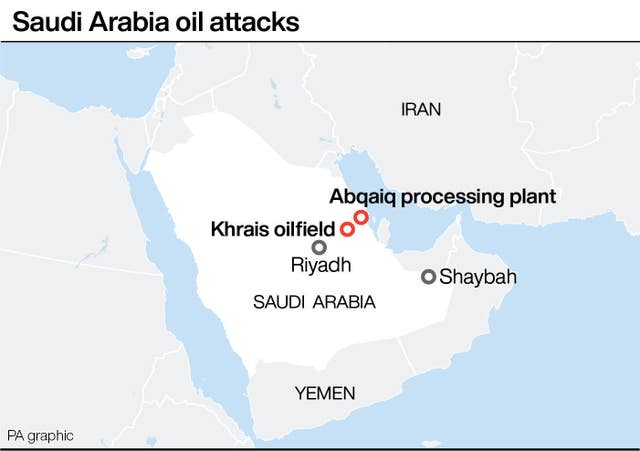
Saudi Arabia has claimed Iranian cruise missiles and drones were used to attack the kingdom’s oil industry, showing journalists the remains of the weapons but stopping short of directly accusing Tehran of launching the assault.
Iran denies being involved in the assault and has threatened the US it will retaliate “immediately” if Tehran is targeted over the attack.
The news conference by Saudi military spokesman Colonel Turki al-Malki came after a summer of heightened tensions between Iran and the US over President Donald Trump unilaterally withdrawing America from Tehran’s 2015 nuclear deal with world powers.

The US alleges Iran launched the attack, which Yemen’s Houthi rebels earlier claimed as a response to the years-long Saudi-led war there which has killed tens of thousands of people.
Col al-Malki did not directly accuse Iran of firing the weapons or launching them from inside Iranian territory. Saudi Arabia has sought help from international investigators and the United Nations, both lengthening the probe and internationalising its conclusions.
“The attack was launched from the north and was unquestionably sponsored by Iran,” Col al-Malki told journalists.
The news conference took place against a backdrop of broken and burnt drones and pieces of a cruise missile allegedly collected from the attacks.
Col al-Malki described the drones as “delta wing” models, which looked like large triangles. The cruise missile, which he described as a “Ya Ali” type, had a small jet engine attached to it.

Eighteen drones and seven cruise missiles were launched in the assault, he said, with three missiles failing to make their targets.
He said the cruise missiles had a range of 435 miles, meaning they could not have been fired from inside Yemen.
He played surveillance video he said showed a drone coming in from the north. Satellite images released earlier by the US showed damage largely on the north-facing sides of structures at the sites.
He said: “This attack did not originate from Yemen, despite Iran’s best effort to make it appear so.”
Saturday’s attack struck the world’s biggest oil processing facility as well as an oil field. Yemen’s Houthi rebels claimed the assault, but the US alleges Iran was behind it.
Iran has warned the US that any action against it will “immediately” be met with a response from Tehran, its state-run news agency has reported.

Iran’s president and foreign minister also may skip next week’s high-level meetings at the United Nations as the US has yet to issue them visas, IRNA reported.
The UN meeting had been considered as an opportunity for direct talks between Iranian President Hassan Rouhani and President Donald Trump amid a summer of heightened tensions and attacks after America’s unilateral withdraw from Iran’s nuclear deal with world powers a year ago.
However, the attack in Saudi Arabia and hardening comments from Tehran suggest such talks are increasingly unlikely.

Iran sent a note through Swiss diplomats on Monday reiterating that Tehran denies being involved in the Saudi attack, IRNA reported.
“If any action takes place against Iran, the action will be faced by Iran’s answer immediately,” IRNA quoted the note as saying.
IRNA separately reported that Iran’s first delegation for the annual UN event had not left Tehran due to not having visas. Foreign minister Mohammad Javad Zarif was due to travel to New York on Friday, with Mr Rouhani following on Monday, according to the agency.
As the host of the UN’s headquarters, the US is mandated to offer world leaders and diplomats visas to attend meetings there, but as tensions have risen, the US has put increasing restrictions on Iranians like Mr Zarif.
US secretary of state Mike Pompeo is travelling to Saudi Arabia for meetings after Saturday’s attack on a Saudi oil field and the world’s largest crude oil processing plant.

Saudi Arabia also said on Wednesday that it had joined a US-led coalition to secure the Middle East’s waterways amid threats from Iran, while Mr Rouhani told Saudi Arabia it should see the attack as a warning to end its years-long war in Yemen.
The state-run Saudi Press Agency quoted an unnamed official saying the kingdom had joined the International Maritime Security Construct.
Australia, Bahrain and the UK had already joined the mission.
The coalition aims to secure the broader Persian Gulf region. It includes surveillance of the Strait of Hormuz, the narrow mouth of the Persian Gulf through which a fifth of the world’s oil travels, and the Bab el-Mandeb, another narrow strait that connects the Red Sea and the Gulf of Aden off Yemen and east Africa.
Smaller patrol boats and other craft will be available for rapid response. The plan also allows for nations to escort their own ships through the region.
The US blames Iran for apparent limpet mine explosions on four vessels in May and another two in June sailing in the Gulf of Oman near the Strait of Hormuz, something Tehran denies. Iran also seized a British-flagged oil tanker and another based in the United Arab Emirates.


Comments: Our rules
We want our comments to be a lively and valuable part of our community - a place where readers can debate and engage with the most important local issues. The ability to comment on our stories is a privilege, not a right, however, and that privilege may be withdrawn if it is abused or misused.
Please report any comments that break our rules.
Read the rules hereLast Updated:
Report this comment Cancel